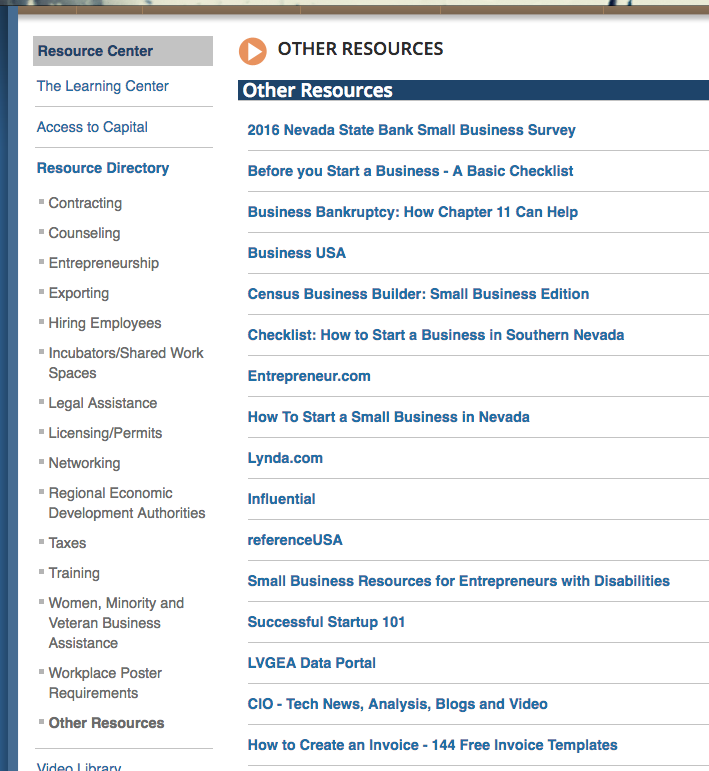by Venchito Tampon Jr | Last Updated on June 29, 2023
What is linkerati?
Linkerati refers to Internet users who are highly likely to be targeted by a linkbait campaign. It is essentially a group of individuals who are known for being influential in the online community. By understanding and engaging with the linkerati, marketers can strategically create content that appeals to this specific audience.
Linkeratis (coined by Rand Fishkin), also known as linkers, genuinely link to content in two ways:
- Active – they constantly search for new references/resources to include on their resource page.
- Passive – they wait for other people’s suggestions of recently published linkable assets that might serve as additional citations for their content works.
In this post, I’ll be sharing actionable tips on how you can identify and find active and passive linkeratis (linkers), as well as how you can approach them effectively to build or earn links (with a few given examples).
How to Find Linkeratis?
1. Leverage Link Neighborhood
In scaling link prospecting, it should be a vital part of your process to constantly look for untapped sources of link opportunities regardless of the difficulty and depth level of the niche you’re working in.
If you make serious efforts to dig into new link sources, it will help speed up your collection of high-quality link targets in your industry – reducing the time you have to spend finding hundreds of link opportunities.
One way to scale link prospecting is by leveraging link neighborhoods.
Link neighborhoods are surrounding external links on a page where your primary link target has been found.
For example, in this resource page that I’ve prospected for a broken link building campaign for a finance client, I’ve seen a Payment Processing section that includes SaAs payment gateway/processing tools (Stripe, Braintree, Square, and NMI).
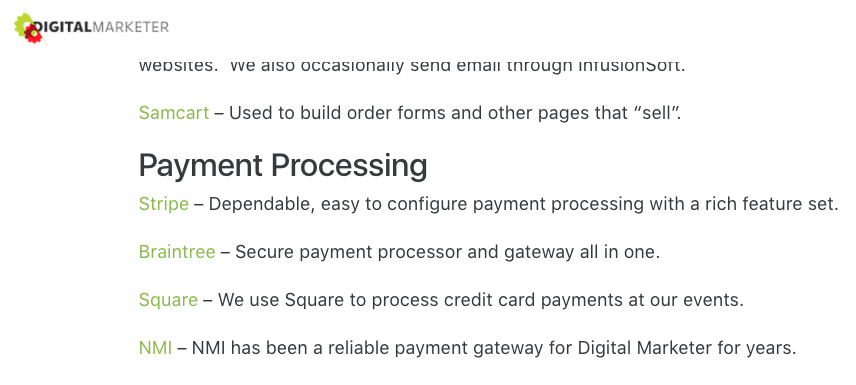
While these websites are non-competitors of my client from content and direct product competition perspectives, there might be relevant opportunities if I start to reverse engineer their inbound links.
I chose Stripe, a SaAs online payment platform among the tools listed, as it has a Domain Authority (DA) of 84.

It is best to check the website’s Domain Authority or Page Authority to quickly assess and sense if there are possible linking pages before reverse engineer all of them for any pointing links because checking low-DA sites for links may not reveal a handful of opportunities in most cases.
Also, I consider industry tools and products to reverse engineer on, as they normally can acquire links from resource pages given their utility as the context for linking (i.e. Resources for Entrepreneurs).
Checking all links pointing to Stripe, we gathered 25~ qualified resource pages for potential outreach prospects.
With a 3 to 5~ conversion rate in our broken link building service, we can acquire resource backlinks, including this link from a resource page (which is exactly a page linking to Stripe).
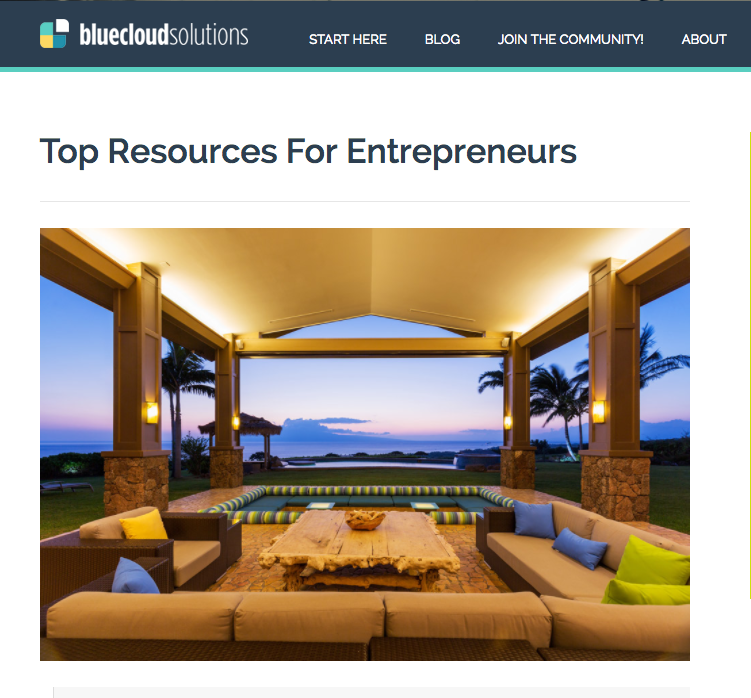 In addition, if you want more efficiency, you can also assess the page’s number of potential linking pages. The best tool to use is LinkMiner chrome extension. It has an option to quickly see the page’s number of linking root domains (LRDs).
In addition, if you want more efficiency, you can also assess the page’s number of potential linking pages. The best tool to use is LinkMiner chrome extension. It has an option to quickly see the page’s number of linking root domains (LRDs).
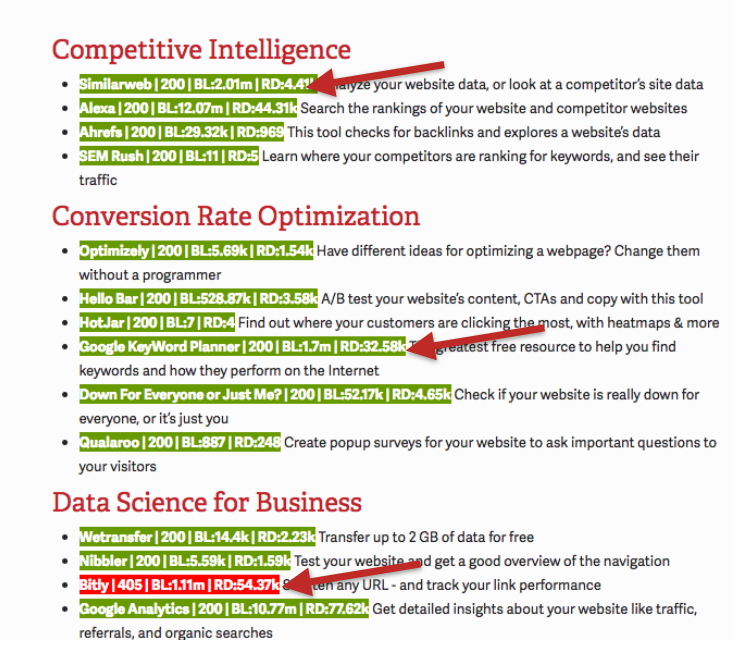
Although the data is based on Ahrefs API that you must set up if you’re a subscriber of the tool, that little change you’ll add to your link prospecting process is highly worth your time.
2. Tap Exclusive Linkable Markets
Linkable markets can be separated into two divisions: inclusive and exclusive.
Inclusive markets are more receptive to outreach emails than exclusive ones, as they’re less often pitched by bloggers and outside publishers (on average, they may only receive ~10 emails daily). These are low to mid-tier bloggers who aren’t yet at the pedestal of their industries but already have a good blog audience and social following.
Meanwhile, exclusive markets constantly receive an estimate of ~100 outreach emails a day (even more to some publishers) that (the act of pitching) unintentionally pushes them to only respond to quality emails.
Examples of exclusive linkable markets are news writers, journalists, and high-tier bloggers.
While there are a lot of opportunities in the inclusive linkable market to capitalize on, it’s also essential to spend time tapping the exclusive linkable market since this is where most authority links may come from.
To get responses and conversion links from pitching these exclusive markets, you may need to have pre-existing connections with them or have an interesting story that can capture their attention to cover your brand on their websites.
But there’s one great tool that can help you secure link placements from exclusive linkable markets – HelpAReporterOut (HARO).
HARO is an email service that benefits both brands and journalists – by providing journalists with sources for upcoming stories and gives brands branding opportunities for their stories to get covered on relevant high-tier industry blogs and top news sites.
Lately, I’ve been spending 20 minutes a day answering queries from publishers and journalists that are all coming from HARO”s daily emails.

In answering press requests, picking topics you’re knowledgeable about and passionate about is imperative. In my case, I only answer office productivity, link building, time management, and teen addiction queries.
To get you started with the process, I highly recommend that you check out this post by Matthew Barby for insights on how to semi-automate, picking relevant HARO press queries and answering them effectively.
For HARO requests you’re unfamiliar with, you can forward them to your client or hire an expert writer from Upwork (I got this tip from Christian Sculthorp) who are knowledgeable on that certain topic of your brand.

This will ensure you’ll get a higher positive rate from publishers likely to include your citation/story in their content.
3. Target Big Interest Areas in the Blogosphere
The blogosphere has evolved throughout the years in terms of the number of online enthusiasts from different industries who are building their personal and corporate brands.
Outside of the tech world (where huge blogs are stunning in numbers), there are indoor and outdoor enthusiasts alike, travelers, foodies, and DIYers who can link to external recommended resources.
Creating content assets that will serve these big interest areas can give you higher chances of building and earning links from the linking enthusiasts.
For a plumbing client, for example, you can produce an instructographic targeted to DIYers that shows how to fix simple plumbing stuff at home.
Brainstorming a little further can give you ideas that can serve your city’s homeowners well. This may be unwise from a conversion perspective (as to who would buy from the market if you teach them DIY guides), but for link acquisition purposes, this is highly practical to target if you consider both quantity and quality.
Moreover, the impact of social shares and natural links garnered from link bait content can translate to more linking opportunities from direct linking enthusiasts and other industry markets to generate new business leads.
John Doherty, for instance, is a search marketing specialist (founder of Credo) who has tapped big interest areas such as travel and productivity since these topics align with his interests and passion.
With that mindset of tapping big interest areas, he acquired editorial links from top-tier sites using HARO.
If the industry you’re in is too boring from a content marketing and link building perspective, try to come outside your market and check if there are peripheral interest areas close to your niche.
4. Generate Content Ideas from Niche-specific Podcasts
In this age of the web, pretty much everyone regularly consumes information through video or audio, not just entertainment content.
The idea that time is a valuable asset allows people to consume content while acting on other things (i.e. while driving) to make every second/minute productive.
Podcasting, for example, is becoming mainstream, as everyone in every specific niche is starting to build their own personal brands to capture as many audio listeners as possible who might be potential customers or clients shortly.
If you’re stuck with what content topics/themes to create for a specific industry, checking or listening to the latest industry podcast series, where that so much valuable information in store, can be extremely helpful in generating niche-specific content ideas for your brand.
For example, this Inside the Mind of Teens and Tweens podcast (searched from Podcast Addict) has 118 podcast episodes (the current number of items in Itunes) that are educational in nature with a targeted audience composed of teachers, parents, and counselors. 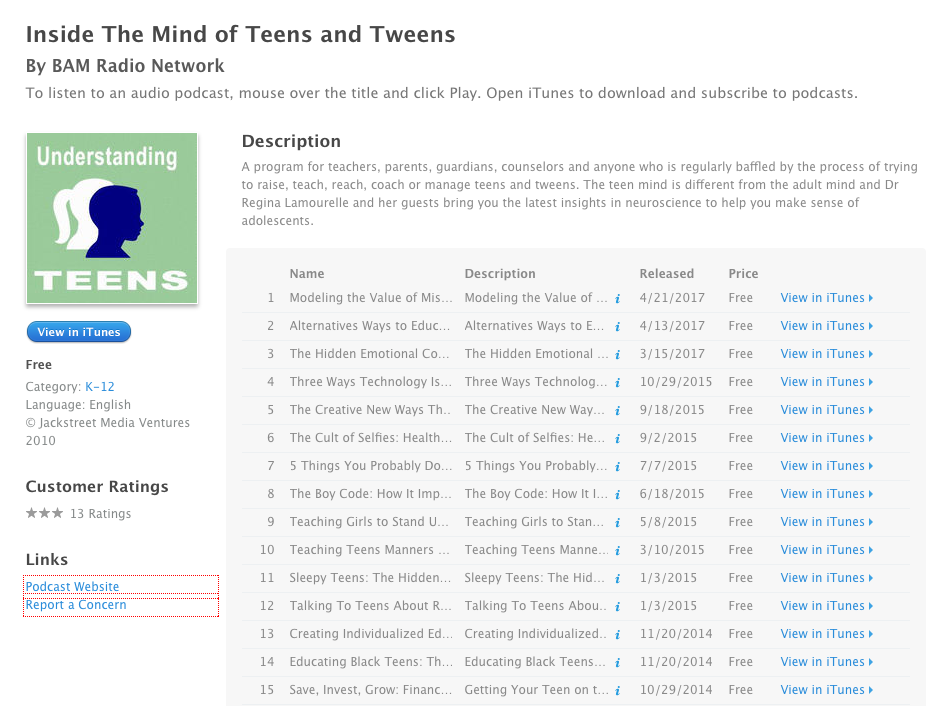
If you’re in the neuroscience space, you can generate some content topics here that can be brainstormed and picked for a linkable content asset.
You can research if there’s linkability in keywords found on these episode topics to ensure enough linking sites to market your content to.
Grab and check some and assess if there are considerable linkable markets by checking each ranking page’s unique referring domains.
For instance, the “sexual health” keyword (derived from one of the episodes above) has hundreds of linking opportunities to the most ranking pages for that search term.
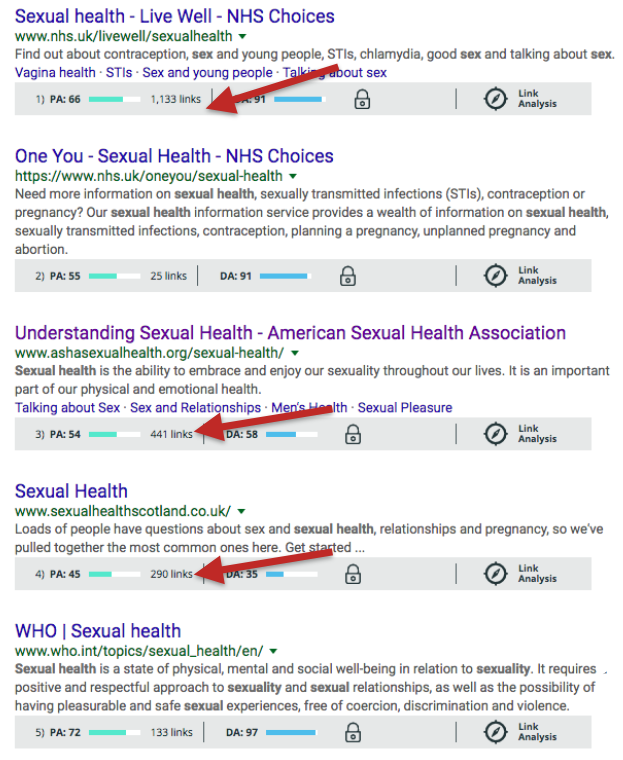
If you’re taking linkable content creation campaigns for clients, that approach is a good practice to take on to semi-automated content brainstorming process for their websites.
How to Reach Out to Linkerati?
After completing your initial list of link prospects, the next step is to strategize how you will approach them. It’s vital to know how they behave as linkers to customize your pitch better so you can stand out among all the pitches they’ve received multiple times a day.
Here are some actionable ways to improve your outreach pitches by 5% better to see greater link acquisition results:
1. Identify Who Handles and Controls Pages
If you are doing large-scale link outreach campaigns, you probably have stumbled across many websites where the webmaster doesn’t have the authority/decision to update the page. Some of them are only capable of fixing errors on any page of the entire website, but they have to put another person in the email conversation to decide whether or not your link can be included in their resource page.
Linkeratis in most .edu websites strictly decide which resources to include in their pages – that means that it’s not a guarantee that you’ll acquire a link unless they’ve seen your content piece as a valuable reference for their audience.
Asking the person up-front (like saying, “Can you forward this to the right contact person?”) if you’re unsure whether the email you’re pitching to will respond is a subtle tactic to consider when doing the initial pitch.
Emails like services@domainname.edu may connect you to a career service representative or admission department staff of a .edu site but not to the tech/admin person who handles the resource page you want to get a link from.
Meanwhile, if you receive responses that let you forward your resource suggestions to a certain person, creating another message with a subject line where you got his email is best.
For example, I’ve received this response from a .gov agency staff that I pitched, which she (the person I emailed with) includes an email of the right person to contact.
Below is an example of a little addition to the common approach of forwarding the email but it’s one effective way to let link granters (the ones who update resource pages know where you got their emails.
 We’ve acquired a .gov (DA89) link (not bad for a quick content suggestion email).
We’ve acquired a .gov (DA89) link (not bad for a quick content suggestion email).
B. Provide Shared Mission and Interest in Outreach
Knowing the value proposition of your content up-front is an important step to better position your email in front of your potential link targets.
But more than just sharing your content’s value proposition to your outreach prospects, defining your shared mission with them is imperative.
For example, this resource page in the small business sector covers different recommended tools and resources that provide information for startup entrepreneurs.
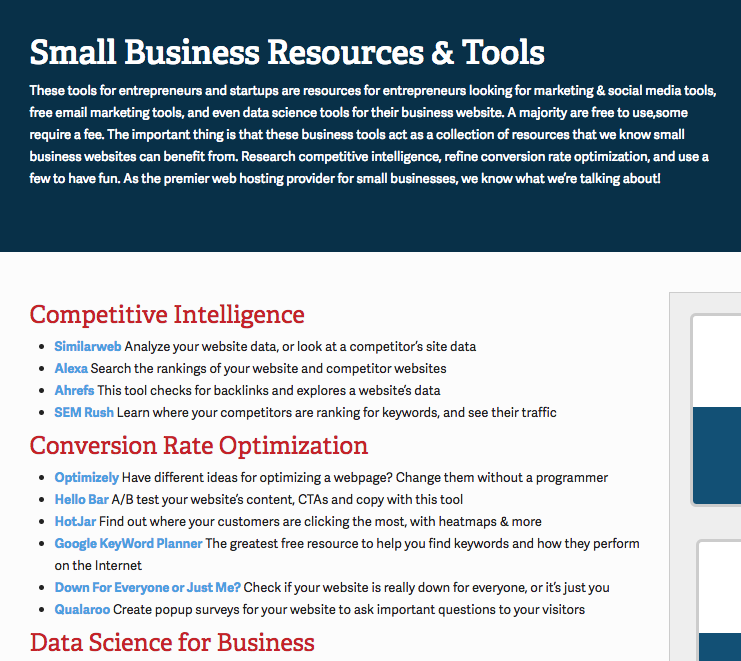
Besides checking the relevance fit of our content’s client to their resource page, it’s our own way of simply adding how the content can best help their audience within the same context of their mission.

These simple addition texts to your email can help position your content’s utility to the audience (being targeted by the resource page) and, thus, increases the likelihood of getting a contextual link.
It’s a good idea for industry blogs to compliment their recent article or website only if it’s authentic to say that their blog is well-designed, for example, or if they have given great insights for a particular topic in their latest blog post.
Saying compliments to get responses and links is less effective than making outreach emails as plain and straightforward as possible.
C. Include Outright Content Suggestions in Link Outreach
Little tweaks in an outreach template can make or break the success of an outreach campaign. Far more if these small changes are predicated on actions made by the linkeratis themselves.
For example, you may have come across resource pages that mention their willingness to accept content suggestions for their links pages outright or to email them for any defunct links visitors see for webmasters to fix them by simply removing them and replacing them with new relevant, and updated resources. 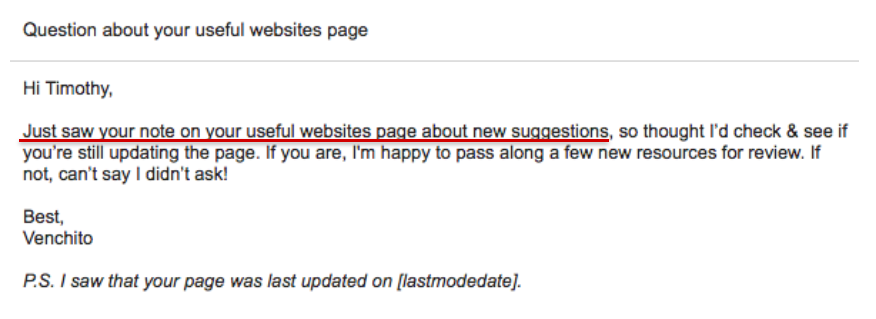
If you remind them in your outreach pitches that those links were stated on their resource page (and they let you tell them to do so), they’ll more likely be positive to your pitch.
While it’s not a guarantee to acquire a link, it’s a differentiator to several link request emails they receive to get a link from that page.
D. Drive Curiosity with Refined Outreach Process
With the inbox flood the industry bloggers and publishers are experiencing daily, outreach pitches need to be refined over time to land more coverage from target blogs/sites.
Quality assurance on email templates for any contextual errors and adding/changing tags for personalization can close the gap between good and great outreach pitches.
But besides these basics (must-have) of outreach, learning the psychology of conversations to secure positive responses can tremendously bring better link results.
SiegeMedia’s outreach team, for example, was able to increase outreach placement rates by 63% by refining their outreach process – which was inspired by Brian Dean’s outreach strategy on providing custom intros for guestographics.
The refined outreach method of SiegeMedia looks like this:
1. A pitch is sent to the recipient, explaining in 100 words or less what the piece of content is and why we thought they’d be interested. This pitch does not include the link to view, rather says if they’re interested to let us know and we’ll forward along.
2. If response is positive, we then forward them the link to the content. In addition, we offer to write a custom intro to support the post if needed.
3. If there’s no response after forwarding the link, we follow up with the blogger if they’ve gone silent after 3-7 business days.
It’s one way to seek new outreach tactics, but it’s a better way to keep and improve older techniques that can also apply not just to one specific content asset (infographics, for example) but also to other content formats that might obtain the same or even better results.
Linkerati Frequently Asked Questions
Does link building still work?
Yes, link building still works for SEO. However, it’s no longer about quantity over quality. Building high-quality and authoritative backlinks is crucial for improving search engine rankings and increasing organic traffic to your website. Focus on earning relevant and valuable links from reputable websites to see the best results.
Is link building good for SEO?
Yes, link building is an effective SEO tactic. Links act as indicators to Google that your website is credible and valuable. Websites with more high-quality backlinks often rank higher in search results. Thus, incorporating link building strategies can improve your SEO efforts and increase your website’s visibility.
How does link building work?
Link building involves acquiring backlinks from other websites, which are seen as votes of confidence by Google. This process helps increase your website’s authority and visibility in search results. By attracting links through valuable content and earning mentions as a reliable resource, you can enhance your website’s search engine rankings and organic traffic.
The Author
Venchito Tampon Jr
Venchito Tampon is a Filipino Motivational Speaker, Corporate Trainer, and a Leadership Speaker in the Philippines. He is the CEO and Co-Founder of SharpRocket, a link building agency. With a decade of experience, Venchito has a proven track record of leading hundreds of successful SEO (link builidng) campaigns across competitive industries like finance, B2B, legal, and SaaS. His expert advice as a link building expert has been featured in renowned publications such as Semrush, Ahrefs, Huffington Post and Forbes. He is also an international SEO spoken and has delivered talks in SEO Zraz, Asia Pacific Affiliate Summit in Singapore, and Search Marketing Summit in Sydney, Australia. Check out his other businesses, Hills & Valleys Cafe, Blend N Sips and Saas Pursuit.
How our LINK BUILDING AGENCY builds 250 links/mo consistently using Predictable Link Building Methodology™…
- Using a SIMPLE and PROVEN system
- Using a SCALABLE strategy
- No private blog networks
- No creepy outreach emails
